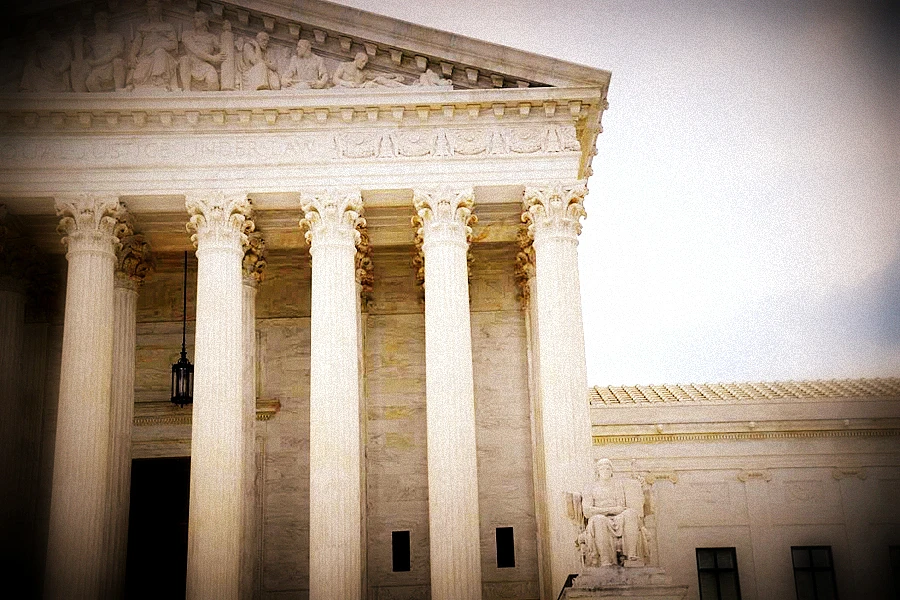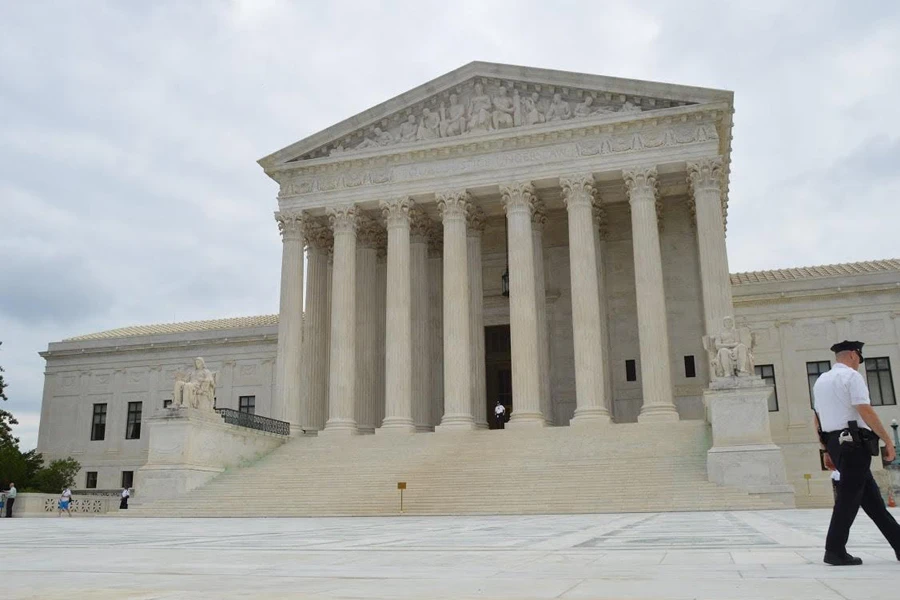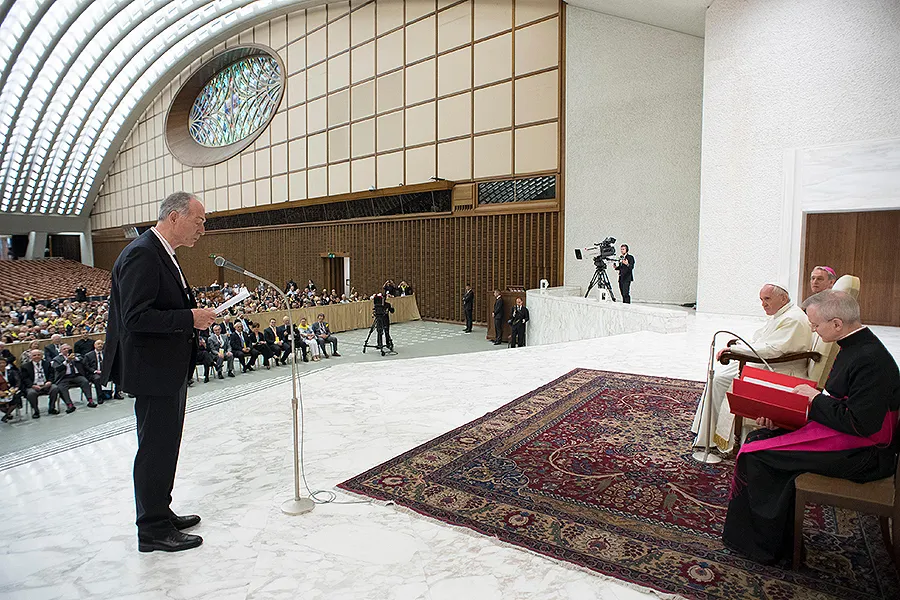The bishops have spoken up on two very different issues – and now the Supreme Court will, too

Washington D.C., Jun 26, 2017 / 12:38 pm (CNA/EWTN News).- As the Supreme Court wrapped up its latest term on Monday, it agreed to consider a major religious freedom case, as well as the case of President Donald Trump’s travel ban, this fall.
Both topics have drawn concern from the U.S. bishops, who have urged respect for freedom of conscience and religion in the face of legalized gay marriage, while criticizing the travel ban for abandoning vulnerable refugees in need.
The court agreed to hear two cases next term which could prove to have major impacts – the constitutionality of President Donald Trump’s travel ban, and the case of Masterpiece Cake Shop v. Colorado Civil Rights Commission, which involves the rights of a baker to refuse out of conscience to provide a wedding cake for a same-sex wedding.
The latter case was relisted 14 times by the Supreme Court, which finally took it up on Monday, SCOTUSBlog.com reported.
“The issue in this case is a free speech case; whether or not the state of Colorado can coerce a person to write a message through culinary arts that violates his conscience,” said Michael Farris, president and CEO of Alliance Defending Freedom, which represents the baker Jack Phillips in the case.
Phillips, who owns Masterpiece Cakeshop in Lakewood, Colo. and has run the shop for over 23 years, explained on Monday how he operates his business in accordance with his religious beliefs.
The shop is “not just a bakery, but a place where I can use my artistic vision and talents to create cakes that communicate just the right message for my clients,” he said. “I gladly welcome and serve everyone that comes into my shop.”
His store is closed on Sundays and he refuses to craft cakes with messages that run contrary to his values, such as anti-American, atheist, or racist messages. He added that “my sincerely-held religious belief that marriage is a sacred relationship between a man and a woman.”
“In 2012, I was stunned when I became the target of a lawsuit relying on sexual orientation gender identity law that offers no exemptions for people of faith,” he said.
After he had declined to make a wedding cake for the same-sex wedding of Charlie Craig and David Mullins, the Colorado Civil Rights Commission said he had violated the state’s anti-discrimination law. The couple was able to obtain a rainbow-themed cake at another shop in the vicinity of Masterpiece.
Phillips said he was barred by the commission from serving any weddings and ended up losing 40 percent of his business, “a crushing loss.” He was also ordered by the commission to enter anti-discrimination re-education, and submit quarterly reports on updating the policies of the business.
Furthermore, Phillips said he began receiving “vile and hateful calls at the shop, including one death threat that was so bad, that I hid my daughter and granddaughter in the back until the police arrived.”
On Monday, after the Supreme Court agreed to take Phillips’ case, lawyers for ADF hoped that the Court would ultimately uphold his free speech rights.
“We’re hopeful that the Court will affirm the basic principle that the government cannot punish artists like Jack for refusing to create art that violates his religious convictions,” said senior counsel Kristin Waggoner.
In an unsigned opinion, the Supreme Court also ruled on Monday that a travel ban on visitors from six majority-Muslim countries may go into partial effect, as the ban awaits a hearing and full consideration by the high court in October.
The court blocked full implementation of the executive order originally released by President Donald Trump in January, saying that the ban “may not be enforced against foreign nationals who have a credible claim of a bona fide relationship with a person or entity in the United States.”
Thus, family members, students and employees from the six designated countries who wish to visit, live or work in the United States will be able to do so. Those who lack such ties to the U.S. will be banned under the executive order.
The order in question bars persons from six majority-Muslim countries – Iran, Libya, Somalia, Sudan, Syria and Yemen – from entering the United States for 90 days, and also requires that refugees wait 120 days before entering the country. The executive order also lowers the number of refugees accepted by the United States in FY 2017 to 50,000 – down from the 110,000 person limit and the 85,000 refugees accepted in actuality during FY 2016.
Initially released January 27, the executive order was then revised on March 6 after judicial challenge. The modified version removed Iraq from the list of countries subject to the ban, and also walked back provisions that would have prioritized refugee admissions for persecuted religious minorities.
The bans were challenged by courts in Maryland and Hawaii, who blocked them from taking effect. Those rulings were later upheld by federal appeals courts in Virginia and California, respectively, on grounds that they violated the Establishment Clause of the U.S. Constitution. The federal government appealed those rulings to the Supreme Court, asking that the stay be lifted and the ban go into effect until arguments are heard before the Supreme Court later this year.
The Supreme Court’s decision only removes part of the stay on the administration’s executive order, allowing the travel and refugee bans to continue against those with no existing ties to the United States. Many of the plaintiffs in the original cases brought in Hawaii and Maryland had family members, schools or employers based in the U.S.
The executive order has come under harsh criticism by the U.S. Bishops and Catholic refugee experts. Bishop Joe Vasquez of Austin, chair of the U.S. bishops’ committee on migration, stated that the bishops were “deeply troubled by the human consequences of the revised executive order on refugee admissions and the travel ban,” after the ban’s March revision. “The revised Order still leaves many innocent lives at risk,” he said.
“The U.S. Catholic Bishops have long recognized the importance of ensuring public safety and would welcome reasonable and necessary steps to accomplish that goal,” the bishop said.
“However, based on the knowledge that refugees are already subjected to the most vigorous vetting process of anyone who enters the United States, there is no merit to pausing the refugee resettlement program while considering further improvement to that vetting process.”
Bill O’Keefe, vice president for advocacy and government relations at Catholic Relief Services, echoed many of Bishop Vasquez’s sentiments, urging in a March 6 statement that “now is not the time for the world’s leader in refugee resettlement to back down.”
The U.S. Catholic Bishops Conference runs one of the nation’s largest refugee resettlement agencies, helping to resettle more than a quarter of all of the refugees admitted to the United States annually.






